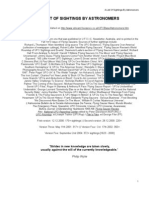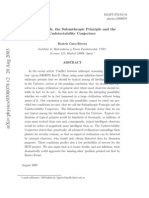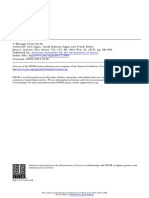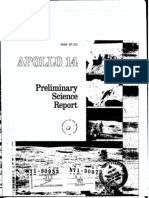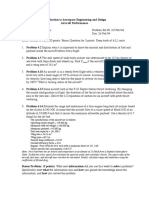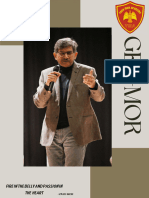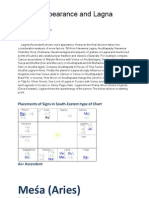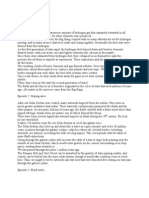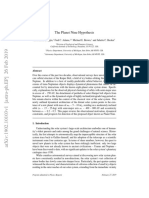Issue1 Astrobiology
Issue1 Astrobiology
Uploaded by
TarpafarCopyright:
Available Formats
Issue1 Astrobiology
Issue1 Astrobiology
Uploaded by
TarpafarCopyright
Available Formats
Share this document
Did you find this document useful?
Is this content inappropriate?
Copyright:
Available Formats
Issue1 Astrobiology
Issue1 Astrobiology
Uploaded by
TarpafarCopyright:
Available Formats
National Aeronautics and Space Administration
#1
Issue
www.nasa.gov
Produced in 2010 by the NASA Astrobiology Program to commemorate 50 years of Exobiology and Astrobiology at NASA.
A History of Exobiology and Astrobiology at NASA
This is the story of life in the Universeor at least the story as we know it so far. As scientists, we strive to understand the environment in which we live and how life relates to this environment. As astrobiologists, we study an environment that includes not just the Earth, but the entire Universe in which we live. The year 2010 marks 50 years of Exobiology and Astrobiology research at the National Aeronautics and Space Administration (NASA). To celebrate, the Astrobiology Program commissioned this graphic history. It tells the story of some of the most important people and events that have shaped the science of Exobiology and Astrobiology. At only 50 years old, this field is relatively young. However, as you will see, the questions that astrobiologists are trying to answer are as old as humankind.
Astrobiology
Concept & Story
Mary Voytek Linda Billings Aaron L. Gronstal
Artwork
Aaron L. Gronstal
Script
Aaron L. Gronstal
Editor
Linda Billings
Layout
Jenny Mottar
Copyright 2010, NASA Astrobiology Program
Issue #1The Origin of a Science
This year marks the 50th anniversary of NASAs Exobiology Program, established in 1960 and expanded into a broader Astrobiology Program in the 1990s. To commemorate the past half century of research, we are telling the story of how this field developed and how the search for life elsewhere became a key component of NASAs science strategy for exploring space. This issue is the first in what we intend to be a series of graphic history books. Though not comprehensive, the series has been conceived to highlight key moments and key people in the field as it explains how Astrobiology came to be. -Linda Billings, Editor
Astrobiology.
Exobiology.
In scientific circles, many people use these terms interchangeably. But what do they mean? In short, they are used to describe the study of lifes potential in the Universe and the origin and history of life on our own planet. Astrobiologists study anything and everything about life on Earth in order to understand how life might arise and survive elsewhere in the Universe.
Background Image: 30 Doradus Nebula (1)
Astrobiologists are also interested in how Earth life is able to survive and adapt when leaving our planet. They are studying life forms like algae and other Earth microorganisms, and trying to figure out if they could live on other planets like Mars. So really, astrobiologists study how life might begin and survive anywhere in the Universe.
Astrobiology as a field of science includes many disciplines, from astronomy to biology. But all astrobiologists work to understand the origin of life on Earth and potential for life on other worlds (2).
Astrobiology can include everything from studying the fundamental principles of how living cells form to searching the skies for Earth-like planets around distant stars. This broad range of scientific pursuits can make Astrobiology difficult to explain.
Earth is the only example we have of a habitable planet for life as we know it. So how do astrobiologists do their work?
If we havent found aliens yet what do they study?
When searching for life in the Universe, what do we look for and how do we look for it?
Humans have long been fascinated with the potential for life in the Universeeven before people knew what the Universe was. Ancient cultures had a variety of explanations for what the stars and planets were, but nearly all of them believed in the possibility of life forms much different from those they saw on Earth.
Twenty-three centuries ago, the Greek philosopher Epicurus wrote about the existence of other worlds in a letter to Herodotus (300 BCE).
With regard to living things, it cannot be proven that the seeds from which animals, plants and other things originate are not possible on any particular worldsystem. There are many different translations and interpretations of Epicurus words, but it is clear that he did not believe the Earth was the only inhabited world in existence.
There are an infinite number of worlds, some like this world, others unlike it.
Epicurus 341 BCE270 BCE
Astronomers have played an important role in helping us understand that Earth is not the only world in the Universe. The discovery of other planets and moons helped to spark ideas that the Earth might not be the only world with life.
Christiaan Huygens (1629-1695) discovered Saturns moon, Titan.
Galileo Galilei is one of the most famous astronomers in history. He perfected the early telescope and made some truly profound observations of the Solar System. In 1610, he observed:
I have seen Jupiter accompanied by three fixed stars, totally invisible by their smallness The planets are seen very rotund, like little full moons (3).
Giovanni Cassini (1625-1712) was the first to observe four of Saturns moons, including Iapetus.
Galileo 1564-1642
In fact, Galileo had discovered Jupiters largest moons. He later identified Io, Europa, Callisto and Ganymede. This is why we refer to them as Galilean satellites today.
The bodies of the planets are solid like that of our Earth. These new Earths may be stocked with plants and animals (4).
In the 1920s, scientists like the Russian Aleksandr Oparin and Englishman J.B.S. Haldane were trying to determine how life began on Earth.
I believe the early Earth had a reducing atmosphere* Agreed.**
Through independent research, they both proposed somewhat similar ideas.
Composed of methane, ammonia, hydrogen and water vapor.
I believe it was CO2, ammonia and water vapor. CO2 provided the source of carbon for life my good chap. Da, but methane could also provide carbon for life. And prebiotic life most likely began with molecules in the atmosphere that were then deposited in the oceans. Agreed.
Increasingly complex organic molecules were created in the presence of ultraviolet radiation.
Nyet. Life arose in the process of the evolution of matter. Basic organic molecules organized into localized systems like primitive cells.
The theories of Oparin and Haldane would later influence one of the most important origin of life experiments to date
*Translated from Russian **Translated from British
Stanley Miller was a young graduate student working under Nobel Laureate Harold C. Urey
1952. The University of Chicago
Using Ureys calculations for the constituents of the early Earths atmosphere along with Oparin and Haldanes theories
I am going to attempt to synthesize molecules necessary for life by simulating conditions on the early Earth thereby testing the theory of chemical evolution.
First, Ill seal gases that were thought to be present on the early Earth in an airtight container.
Methane Ammonia Hydrogen
No oxygen.
This simulates the oceans and atmosphere of the early Earth.
These chemicals are sealed in sterile tubes and flasks that create a loop.
The water is heated...
But the real trick is to simulate the energy provided by flashes of lightning in the ancient atmosphere of the Earth (5).
We do this with sparks of electricity.
After our little lightning storm, we let the atmosphere inside our bottles cool off again. This allows water to condense inside the bottles and trickle down through the tubes
where we can collect samples to see what has happened.
Amazingly, we get organic compounds that contain carbon. These compounds include things like amino acids, sugars, lipids and other molecules that are vital for living cells.
Just turning on the spark in a basic pre-biotic experiment will yield 11 out of 20 amino acids used by life on Earth (5).
Other key steps in the 20th century were major advances in the fields of biology and chemistry that would later provide astrobiologists with the tools they needed to examine life at the molecular level. DNA is a big helix in several chains. Phosphates on the outside phosphate-phosphate inter-helical bonds disrupted by water (6).
British scientist Rosalind Franklin was a key figure in biology. Her work with x-ray diffraction would provide clues to the structure of one of lifes most important moleculesDNA. Franklins data was the foundation for the work of James D. Watson and Francis Crick, who put forward their theory of the DNA helix in 1953. We have found the secret of LIFE!!!
Watson and Crick provided the world with a visual understanding of how nucleotide base pairs fit together to ultimately provide the fundamental blueprint for life as we know it. Their paper hit the stands in 1953, following their now infamous announcement at the Eagle Pub in Cambridge, England. Only three weeks later, Stanley Miller and Harold Urey published their equally famous paper on the chemical building blocks of life. In 1962, Watson and Crick, along with molecular biologist Maurice Wilkins, were awarded the Nobel Prize for this invaluable contribution to molecular biology. You look at science (or at least talk of it) as some sort of demoralising invention of man, something apart from real life, and which must be cautiously guarded and kept separate from everyday existence. But science and everyday life cannot and should not be separated. Science, for me, gives a partial explanation for life. In so far as it goes, it is based on fact, experience and experiment (7).
Sadly, Rosalind Franklin passed away in 1958 without receiving the proper credit for her contribution.
Exobiology really began to develop when humankind first gained access to space
Sputnik, 1957
Voskhod, 1963
Skylab 4, 1973
The main players at the time were the United States and the Soviet Union.
Explorer I, 1958 The race to launch people off our planet had begun and nobody knew what would we find or what would happen to Earths first space travelers when they left home.
Space was still the realm of speculation. Early telescopes had led the likes of astronomers like Percival Lowell to theorize about canal systems on Mars carved by intelligent civilizations
Science fiction authors speculated even further about strange societies on other planets in our solar system.
All these visions of bizarre life forms, both benign and dangerous, were still fresh in the minds of the public.
At that time, key figures and critical meetings drove the creation of Exobiology. One such moment came in 1957, when the young microbiologist Joshua Lederberg traveled from the U.S. to meet with J.B.S. Haldane in India.
Following his work in England on the origins of life*, Haldane had relocated to Calcutta.
Lederberg had made a name for himself by demonstrating how bacteria exchange genetic informationresearch that helped give birth to the field of bacterial genetics. Lederberg and Haldane were in awe of the two recent Sputnik satellite launches from the Soviet Union. While watching a lunar eclipse from Haldanes home, they speculated about the effects that human access to space could have on other planets and moons in our solar system.
Both men saw a potential for reckless use of space technologies. Lederberg, with his knowledge of microbiology, was fearful of humans contaminating other celestial bodies with Earth microbes that could damage potential ecosystems on other planets and prevent further scientific study of them (8).
Lederberg also grew concerned about space explorers bringing harmful, alien bacteria back to Earththereby contaminating our own planet. *See page 4.
As we grew more confident in our ability to access space, concerns over our impact on the other planets and moons in the Solar System also continued to grow.
Laika the dog (c. 1954November 3, 1957), was the first animal sent to space. The Soviet Union launched Laika on a one-way trip in 1957 to test the effects of space flight on a living organism.
Achievements in the new Space Race between the USA and the USSR came in rapid succession. In a matter of months, rockets grew larger and larger, allowing for more and more complicated missions.
Ham the chimp (c. July 1956January 19. 1983), the first hominid in space. In 1961, he spent 16 minutes and 39 seconds in flight before returning to Earth.
The animals space flights culminated in the mission of Soviet cosmonaut Yuri Gagarin, the first human being to leave the atmosphere.
On April 12, 1961, the day of his flight, life on Earth had truly left home.
On July 29, 1958, US President Dwight D. Eisenhower signed the National Aeronautics and Space Act. NASA was born.
Sir, I believe there is a need to prevent extraterrestrial contamination of Earth in our endeavors to reach space.
Also, the search for native life on the moons and planets of the Solar System must be a priority.
Joshua Lederberg, fresh from his meeting with Haldane in Calcutta, immediately approached NASAs first deputy administrator Hugh Latimer Dryden. Yes, I see. Dryden quickly appointed Lederberg the head of the Space Science Boards panel on extraterrestrial life.
In the fall of 1958, Lederberg was awarded the Nobel Prize in Physiology or Medicine, but it didnt slow his interest in the science he called Exobiology.
for their discovery that genes act by regulating definite chemical events
Lederberg quickly set about assembling scientists concerned with life beyond Earth. He recruited talented members of the science community, including Melvin Calvin, Wolf Vishniac, Norman Horowitz, Harold Urey and the young Carl Sagan. Horowitz
Calvin
Urey
and for his discoveries concerning genetic recombination and the organization of the genetic material in bacteria(9)
Vishniac Sagan
I would like to get some help from a young astronomer at Yerkes Observatory [named Carl Sagan] who is well informed and deeply interested in planetary biology (10).
My mission in science is nothing less than extending Millers results to astronomy (11).
Background image: Hubble Space Telescope (12) Sagan had already gained an interest in Exobiology when sitting in lectures by Harold Urey at the University of Chicagojust as he and Stanley Miller were making headlines with their origin of life experiments. Lederbergs plea to consider the implications of life beyond Earth struck a chord with Dryden, and soon the young biologist was involved in decision-making at NASA. He was the one who coined the term Exobiology. The enthusiasm of Lederbergs panel for exobiology ensured that, from NASAs very beginnings, core questions in the study of the origin, evolution and distribution of life in the Universe were at the heart of space exploration plans. Lederberg quickly set up dedicated study teamsdubbed EASTEX and WESTEX on both coasts of the United States.
Harold Urey Carl Sagan Melvin Calvin
Italian biologist Salvador Luria chaired the EASTEX group, which included Bruce Billings, Dean Cowie, Richard Davies, George Derbyshire, Paul Doty, Herbert Freeman, Thomas Gold, H. Keffer Hartline, Martin Kamen, Cyrus Levinthal, Stanley Miller, E.F. Mac Nichol, Bruno Rossi, W. R. Sistron, John W. Townsend, Wolf Vishniac, Fred Whipple and Richard S. Young.
Salvador Luria
Bruno Rossi
Wolf Vishniac
Gunther Stent Fred Whipple
Lederberg chaired the WESTEX group, which included Melvin Calvin, Richard Davies, Norman Horowitz, A.G. Marr, Daniel Mazia, Aaron Novick, Carl Sagan, William Stinton, Roger Stanier, Gunther Stent, C.S. van Niel and Harold F. Weaver.
Stanley Miller Keffer Hartline
In 1959, NASA awarded the first grant for Exobiology research to an EASTEX member, the microbiologist Wolf Vishniac of Yale University. He received $4500 to develop the Wolf Trap, a device to detect microorganisms in the soil of another planet. Pretty soon, youll be ready for a trip to Mars (13).
NASA created a Life Sciences office on March 1, 1960. Thanks to the work of scientists like Lederberg, an Exobiology program was established as an important element of this office. The NASA Jet Propulsion Laboratory in Pasadena, California, and the NASA Ames Research Center in Mountain View, California, quickly developed strong Exobiology research groups.
NASA Ames (14) began to recruit new postdoctoral researchers, including Cyril Ponnamperuma and George Akoyunoglou, to focus on Exobiology. Soon, postdocs were working alongside staff scientists at NASA Ames. This development was a major step in recruiting new scientists to the field. Many researchers joined Vishniac in receiving support from NASA in the early days of Exobiology, including several Nobel Prize winners (15). By 1963, NASA had become a significant funding source for life science research in the USA. NASA money also helped build new facilities for universities, including UC Berkeley and Stanford. Below are a few examples of projects funded by the first NASA Exobiology Grants.
Harrison Brown, Problems of Lunar and Planetary Exploration (16).
Joshua Lederberg, Development of the Multivator biochemical lab (16).
Samuel Silver, Biochemistry of terrestrial microbes in simulated planetary environments (16).
Sidney Fox, Study of proteinoid microspheres (16).
Gilbert Levin, Development of the Gulliver life detector (16).
Questions about lifes potential in the Universe have been on NASAs science agenda since the very beginnings of the agency, making Exobiology and Astrobiology research essential to meeting NASAs goals. In 1976, NASA would launch the first planetary exploration mission dedicated to searching for evidence of life on another world, and the work of Exobiology and Astrobiology would truly take off. 17 18
Next issue
Astrobiology travels the Solar System
A History of Exobiology and Astrobiology at NASA
Further Resources and References cited in this issue: 1. The background image on Page 1 is of the 30 Doradus Nebula of the Large Magellanic Cloud. This is one of the most active star-forming regions discovered thus far in our region of the galaxy. This image combines ultraviolet, visible, and red light captured by the Hubble Space Telescopes Wide Field Camera 3. Credit: NASA, ESA, and F. Paresce (INAF-IASF, Bologna, Italy), R. OConnell (University of Virginia, Charlottesville), and the Wide Field Camera 3 Science Oversight Committee photo. Image available online at: http://www.astrobio.net/index. php?option=com_galleryimg&task=imageofday&imageId=216&pageNo=24 2. See the Astrobiology Roadmap at: http://Astrobiology.nasa.gov/roadmap 3. Drake, S. (1978) Galileo at Work: His Scientific Biography, University of Chicago Press 4. Huygens, C. (1968) Cosmostheoros: Book 1 5. EXOBIOLOGY: An interview with Stanley L. Miller. Accessexcellence.org 6. Lecture Notes of Franklin, Colloquium Nov. 1951. The report is typewritten, dated 7 Feb. 1952, in A Sayre, Rosalind Franklin and DNA (1975), 128. 7. Letter to Ellis Franklin, possibly summer 1940 whilst Rosalind Franklin was an undergraduate at Cambridge. Cited in Brenda Maddox (2002) The Dark Lady of DNA, HarperCollins Publishers, 380p. 8. Morange, M. (2007) What history tells us: X. Fifty years ago: the beginnings of Exobiology. J. Biosci. 32(6), September 2007, 10831087 9. www.nobelprize.org 10. http://www.njhn.org/Humanist_Candle_in_the_Dark.html 11. Sagan to Lederberg, 1959, Lederberg Papers, National Library of Medicine. Available at: http://profiles.nlm.nih.gov/BB/Views/Exhibit/narrative/exobio.html 12. Image from the Hubble Space Telescope entitled, A Five Quasar Gravitational Lens. Credit: K. Sharon (Tel Aviv U.) and E. Ofek (Caltech), ESA, NASA. Available from www.hubblesite.org and www.nasaimages.org 13. Wolf Vishniacs instrument, the Wolf Trap, would later become one of four instruments selected to fly on NASAs Viking Mars lander mission. 14. This aerial photograph of what is now the NASA/Ames Research Center was captured by the Navy NAS on May 1, 1936. The distinctive large dirigible hanger can still be seen today when driving past NASA Ames in Mountain View, CA, on California Highway 101. From the Ames Research Center Image Library Collection, Image A93-0073-8 15. Nobel Prize winning scientists involved in early Astrobiology projects with support from NASA included the likes of Lederberg, Calvin, Urey, H.J. Muller, Fritz Lipmann, George Wald, M. Keffer Hartline and Manfred Eigen (Dick and Strick 2005, p. 30) 16. Dick, S.J. and Strick, J.E. (2005) The Living Universe: NASA and the development of Astrobiology. Rutgers University Press, New Brunswick, New Jersey, and London 17. Images captured by the Viking Orbiters: (1) Image of the Mars surface from Viking 1 (1976) (2) Mars moon Deimos as captured by Viking 2 (1977) (3) The infamous face on Mars captured by Viking 1 (1976) (4) Channels and Craters on Mars. Captured by Viking 2 (1976) 18. The comet Tempel 1 as viewed by the NASA Deep Impact mission (2005).
Astrobiology
NP-2010-09-681-HQ
You might also like
- Ebook Tom Irvine Shock Vibration Response Spectra PDFDocument279 pagesEbook Tom Irvine Shock Vibration Response Spectra PDFRohit Dubey100% (3)
- Antonov 225 - The Largest - Airliner in The WorldDocument63 pagesAntonov 225 - The Largest - Airliner in The WorldFridayFunStuffNo ratings yet
- Analog Science Fiction and FactDocument112 pagesAnalog Science Fiction and FactChris K100% (1)
- A List of UFO Sightings by AstronomersDocument48 pagesA List of UFO Sightings by Astronomerssergejsh100% (2)
- Dahl, Per F. - From Nuclear Transmutation To Nuclear Fission (1932-1939)Document317 pagesDahl, Per F. - From Nuclear Transmutation To Nuclear Fission (1932-1939)Max Mxyzptlk100% (2)
- Geometry of Four DimensionsDocument378 pagesGeometry of Four DimensionsMartinAlfonsNo ratings yet
- The-Heaven-on-Earth Observatorios Siglo XIX PDFDocument400 pagesThe-Heaven-on-Earth Observatorios Siglo XIX PDFOscar Gómez100% (2)
- Physical Processes in Circumstellar Disks around Young StarsFrom EverandPhysical Processes in Circumstellar Disks around Young StarsPaulo J. V. GarciaNo ratings yet
- Top Interview QuestionDocument10 pagesTop Interview QuestionMoshiurRahman100% (2)
- Female Astronauts in SPACEDocument141 pagesFemale Astronauts in SPACEEverett SwiftNo ratings yet
- The Mercury 13Document17 pagesThe Mercury 13api-509619591No ratings yet
- 070 January 1972Document4 pages070 January 1972edicioneshalbraneNo ratings yet
- Enrico Fermi and The Dead CatDocument3 pagesEnrico Fermi and The Dead CatAdam CrowlNo ratings yet
- UFO Evidence 1964Document388 pagesUFO Evidence 1964Caleb Voos100% (2)
- Buck Nelson PDFDocument3 pagesBuck Nelson PDFCTRCTR100% (1)
- Hessdalen Lights!: - What's happening in the Norwegian mountains?From EverandHessdalen Lights!: - What's happening in the Norwegian mountains?No ratings yet
- Introduction To The Space AgeDocument16 pagesIntroduction To The Space AgeAnne MillbrookeNo ratings yet
- There Is A Fundamental Unity Beneath This Surface of Diversity. What We See Is But An Illusion at The Molecular Level, All Things Are Connected."Document1 pageThere Is A Fundamental Unity Beneath This Surface of Diversity. What We See Is But An Illusion at The Molecular Level, All Things Are Connected."Aleksina MaticNo ratings yet
- Mars and The Great Galactic GhoulDocument6 pagesMars and The Great Galactic GhoulDan CosteaNo ratings yet
- Carl Sagan - Wonder and SkepticismDocument9 pagesCarl Sagan - Wonder and SkepticismAshok NarenNo ratings yet
- Larin-Wodor-Ziemia 1993Document254 pagesLarin-Wodor-Ziemia 1993api-231134847No ratings yet
- Comets IIDocument726 pagesComets IIsrolandNo ratings yet
- Ice Worlds of the Solar System: Their Tortured Landscapes and Biological PotentialFrom EverandIce Worlds of the Solar System: Their Tortured Landscapes and Biological PotentialRating: 4 out of 5 stars4/5 (1)
- Astronaut Spacesuits HistoryDocument28 pagesAstronaut Spacesuits HistoryAviation/Space History LibraryNo ratings yet
- Maps of The Moon by Thomas A. S. HaddadDocument102 pagesMaps of The Moon by Thomas A. S. HaddadJorge100% (1)
- Clerke A Popular History of Astronomy During The Nineteenth Century (1887)Document532 pagesClerke A Popular History of Astronomy During The Nineteenth Century (1887)Marcelo Silvano de CamargoNo ratings yet
- Metals and Alloys. Hume-Rothery RulesDocument31 pagesMetals and Alloys. Hume-Rothery Rulesलेख् अर्याल्No ratings yet
- 50 Years of Solar System Exploration: Historical Perspectives (With Original NASA Photographs)From Everand50 Years of Solar System Exploration: Historical Perspectives (With Original NASA Photographs)No ratings yet
- The Messenger 183Document44 pagesThe Messenger 183European Southern ObservatoryNo ratings yet
- Beatriz Gato-Rivera - Brane Worlds, The Subanthropic Principle and The Undetectability ConjectureDocument12 pagesBeatriz Gato-Rivera - Brane Worlds, The Subanthropic Principle and The Undetectability ConjectureAndross580No ratings yet
- The Problem of Space Travel - The Rocket MotorDocument5 pagesThe Problem of Space Travel - The Rocket Motortony oneNo ratings yet
- Apollo 13. Answer KeyDocument1 pageApollo 13. Answer KeyOleg Muhendis100% (1)
- Nikodem J. Poplawski - Radial Motion Into An Einstein-Rosen BridgeDocument7 pagesNikodem J. Poplawski - Radial Motion Into An Einstein-Rosen BridgeKunma050No ratings yet
- 022 Dec-Jan 1963-64Document8 pages022 Dec-Jan 1963-64edicioneshalbraneNo ratings yet
- Middle - Late Paleozoic Earth and Life HistoryDocument35 pagesMiddle - Late Paleozoic Earth and Life HistorySab UrlandaNo ratings yet
- Who Invented The TelescopeDocument8 pagesWho Invented The TelescopeWritaban DebNo ratings yet
- The Scientific MethodDocument5 pagesThe Scientific Methodsmoabayomi3575No ratings yet
- Flying Saucers Are Real Donald Keyhoe 1950Document116 pagesFlying Saucers Are Real Donald Keyhoe 1950djsjsjskdjkfkfNo ratings yet
- Intrinsic Redshifts in Quasars and GalaxiesDocument36 pagesIntrinsic Redshifts in Quasars and GalaxiesBryan GraczykNo ratings yet
- UFO Classification SystemsDocument6 pagesUFO Classification SystemsDavid Calvert100% (1)
- Remote Sensing: Application of ScienceDocument19 pagesRemote Sensing: Application of ScienceAlia100% (1)
- Neanderthal and DenisovanDocument2 pagesNeanderthal and Denisovannikita bajpaiNo ratings yet
- LaplaceDocument6 pagesLaplaceJacket TenNo ratings yet
- XypicDocument12 pagesXypicaffe007No ratings yet
- Living Aloft Human Requirements For Extended SpaceflightDocument432 pagesLiving Aloft Human Requirements For Extended SpaceflightBob Andrepont100% (2)
- Newton Opticks (1721) PDFDocument420 pagesNewton Opticks (1721) PDFMarcelo Silvano de CamargoNo ratings yet
- Instead of the ITER project and the TOKAMAK principle: – a new type of fusion machineFrom EverandInstead of the ITER project and the TOKAMAK principle: – a new type of fusion machineRating: 5 out of 5 stars5/5 (1)
- Opticks 1704verDocument412 pagesOpticks 1704verJiro KonnoNo ratings yet
- Significant Achievements in Space Science 1965Document216 pagesSignificant Achievements in Space Science 1965Bob AndrepontNo ratings yet
- Kolli - Is It Ball LightningDocument4 pagesKolli - Is It Ball Lightningshesh_kgNo ratings yet
- How To Construct An Astrolabe, Using Your PC: Astronomy ReportDocument17 pagesHow To Construct An Astrolabe, Using Your PC: Astronomy Reportriquelme_jr100% (1)
- Stealth Satellites A StudyDocument249 pagesStealth Satellites A StudyvonlolzorNo ratings yet
- A Short History of AstronomyDocument405 pagesA Short History of AstronomyesrefyesilcimenNo ratings yet
- New Horizons Fact Sheet 2006Document2 pagesNew Horizons Fact Sheet 2006Bob Andrepont100% (1)
- Astronomical SketchingDocument81 pagesAstronomical SketchingflotoneroNo ratings yet
- A Message From Earth, Carl Sagan 1972Document5 pagesA Message From Earth, Carl Sagan 1972Adriana MorenoNo ratings yet
- Fergusson NORAD CommentaryDocument13 pagesFergusson NORAD CommentaryNunatsiaqNewsNo ratings yet
- Finite Markov Chains and Random Discrete StructuresDocument6 pagesFinite Markov Chains and Random Discrete StructuresClifford StoneNo ratings yet
- NASA Hall 1969 TN D5444 RWY TWY Profile Measurement A BDocument104 pagesNASA Hall 1969 TN D5444 RWY TWY Profile Measurement A BRoger BurtonNo ratings yet
- Apollo Stories - Space History and Law During the Pioneering Years of the Apollo Space ProgramFrom EverandApollo Stories - Space History and Law During the Pioneering Years of the Apollo Space ProgramNo ratings yet
- Enterprise StardustDocument53 pagesEnterprise StardusttzarinchillaNo ratings yet
- Apollo 14 Preliminary Science ReportDocument310 pagesApollo 14 Preliminary Science ReportBob AndrepontNo ratings yet
- Introduction To Aerospace Engineering and Design Aircraft PerformanceDocument1 pageIntroduction To Aerospace Engineering and Design Aircraft PerformancebooksforfunNo ratings yet
- Sub LordDocument2 pagesSub LordshivaprasadamNo ratings yet
- SQL ScriptDocument13 pagesSQL ScriptVlad ChichirauNo ratings yet
- Astro Quiz Study Guide 2023 2Document373 pagesAstro Quiz Study Guide 2023 2Ben DoverNo ratings yet
- Gen2 Letter Final (1Document2 pagesGen2 Letter Final (1michaelkan1No ratings yet
- R V R V: Changes: OPSDocument13 pagesR V R V: Changes: OPSdebertNo ratings yet
- Air Fleet Magazine Issue 35Document76 pagesAir Fleet Magazine Issue 35Mikoyan Gurevich100% (3)
- Pulsejet EngineDocument4 pagesPulsejet EngineBalaji AeroNo ratings yet
- Proceedings of The X15 First Flight 30th Anniversary CelebrationDocument176 pagesProceedings of The X15 First Flight 30th Anniversary CelebrationBob Andrepont100% (2)
- Celestial Navigation Diagnostic Test1Document2 pagesCelestial Navigation Diagnostic Test1Bernard MamoraNo ratings yet
- HOÀ PHÚ - Anh 6 Hoa Phu - 2nd Edition - RevisedDocument3 pagesHOÀ PHÚ - Anh 6 Hoa Phu - 2nd Edition - RevisedhuynhNo ratings yet
- What Are Transits in Astrology? - Lesson 18: AspectsDocument2 pagesWhat Are Transits in Astrology? - Lesson 18: AspectsВадим БатыровNo ratings yet
- 41ST Gen MorDocument41 pages41ST Gen Morsoravrjpt3No ratings yet
- Schmidt - History of Kalman Filter - Nasa ReportDocument25 pagesSchmidt - History of Kalman Filter - Nasa Reportmandolin wind100% (1)
- Laserburn Adventurers CompanionDocument28 pagesLaserburn Adventurers CompanionFoxtrot Oscar100% (4)
- Volume 69 PDFDocument84 pagesVolume 69 PDFShobit Sharma100% (3)
- Appearance and LagnaDocument174 pagesAppearance and Lagnasundar190561No ratings yet
- Concept To RealityDocument233 pagesConcept To RealityVincent S Ryan100% (2)
- Hyper Space NotesDocument3 pagesHyper Space NotesegermindNo ratings yet
- 0741 How To Draw Sls 005042020Document11 pages0741 How To Draw Sls 005042020Aryn PhillipsNo ratings yet
- Paper ManiaDocument17 pagesPaper ManiaWeldon Owen Publishing92% (24)
- Book Number Genre TitleDocument22 pagesBook Number Genre Titleapi-287301687No ratings yet
- Planeta X Nibiru Artigo PDFDocument92 pagesPlaneta X Nibiru Artigo PDFMateus AzevedoNo ratings yet
- Solar Power Satelite Seminar ReportDocument37 pagesSolar Power Satelite Seminar Reportforbugmenot100% (1)
- Times Leader 08-24-2012Document22 pagesTimes Leader 08-24-2012The Times LeaderNo ratings yet



